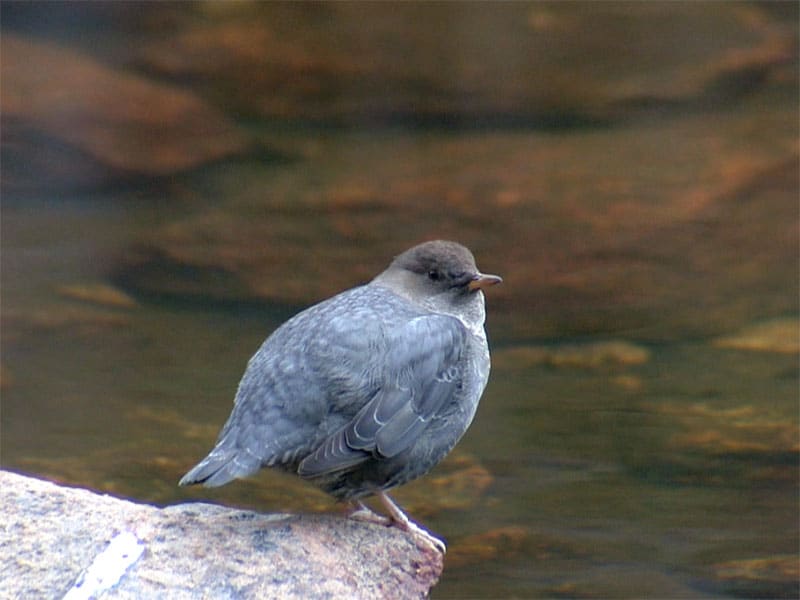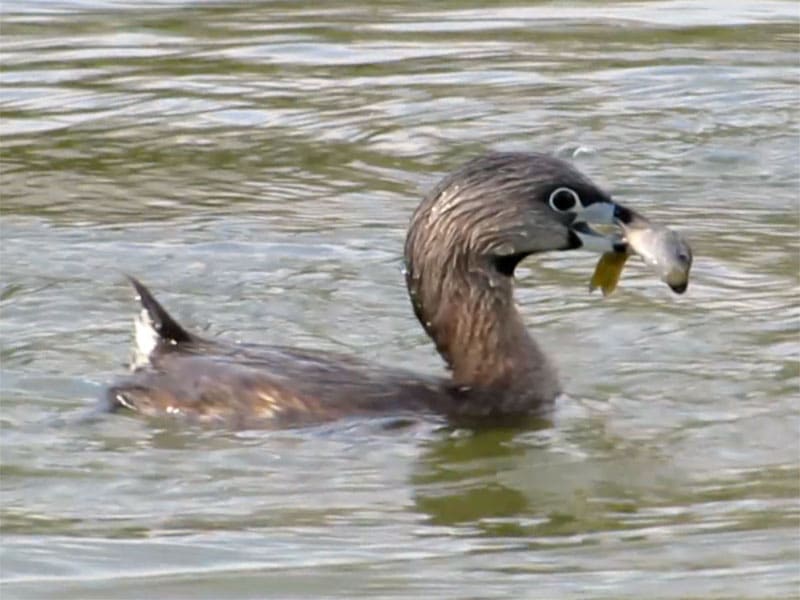Wouldn’t it be delightful if your next-door neighbor was a friendly naturalist? The two of you could stand at your property edge and watch the birds bathing in a stream. She could share tidbits of avian behavior that you would eagerly digest like a grebe swallowing his latest catch. If you’re in the St. Louis area, you do indeed have such a neighbor! Jo Alwood lives with her husband Connie (short for Cornelius) and two cats within the northern edge of St. Louis County.
When I discovered her YouTube channel, I wanted to share the discovery with all my friends. Jo graciously accepted being interviewed and shared a Saturday morning with me. She has more than 250 wildlife mini-documentaries. She packs a lot in her two to four-minute films that feature delightfully well-matched music and her witty and informative narration that seems casually executed.
Connie and Jo are both retired secondary English teachers. Connie became a Master Gardener in 2004. Jo insists he’s the true birder in the home. As he followed a keen interest in the relationship between plant and bird, he has shared his findings by giving presentations.
Eight years ago, Jo stopped political blogging when she became very ill. The correct diagnosis was slow in coming. She was seriously ill for at least a year. Her recovery not only restored her energy but surpassed her energy levels before the illness. She felt better than she had in years. She had all this energy and no direction. That’s when Connie suggested making films about what birds his audiences might see in their gardens seasonally. She was unsure she would be able to film moving subjects. Connie kept saying, “What else have you got to do?” That was the beginning.
Missouri Life: I’d never heard of the American dipper until your video.
Jo Alwood: Yeah, isn’t he cool? I had seen him before but years ago before I paid much attention. Connie’s tried to get me interested in birds for decades. And I was just like, ‘Yeah, they’re nice.’ But, I was not a birder. And I’m still not a birder. I will freely confess that.
I know a lot about the things I film and not much about anything else. There are these huge gaps in my knowledge. I need to start to get down to Riverlands at dawn and see if I can find some ducks before the traffic has scattered them. They’re there and they might be close to shore if I get there first thing. But even if I do, I may not know what I’m looking at. I know some of the grebes. I know what a bufflehead is. I know what a ruddy duck is. I know a few of them but I’m not like a birder. My husband’s been doing this thirty years. He can look at one way the hell out there. If he can see even a little bit, he’ll say, ‘Well, that’s a blah, blah, blah.’ I’ll say, ‘You couldn’t possibly know that!’ But if you’ve been around birders, you know they do!
Because Connie started me on that, I am now doing what I wish I could have been doing all of my life! It only took me ’til I was 71 years old to find my niche in life. But I feel like I have.

ML: I’m sure there are people like me out there who would say that watching your videos are some of their favorite online times.
Jo: Oh, I just love hearing that!
ML: You say your script so casually. I know behind that narration is timing it with the footage that you have put together already in some kind of software [Jo uses Final Cut Pro] and you execute that monologue with a relaxed tone in everything you’re saying.
Jo: I love the way you’re analyzing it. That is exactly what I aim for. To sound unprepared when I am. And to make what I’m saying illustrate what you’re seeing and bring it to life with the metaphors. I can write a script in fifteen minutes but to make it into a good script; that may take days or even weeks of mulling it over and trying to figure out how to make it interesting. I get writer’s block on those metaphors and until I’ve got at least one zinger of a metaphor, I don’t put a movie up.
ML: Does that relaxed-sounding narration come naturally?
Jo: I practice my readings, yeah. And if I don’t like the way it sounds—if it doesn’t sound just right to me—I re-record it. Sometimes, almost an entire script will just come out of me without any re-recording necessary. Other times, there will be one little bit I record ten times because I want it to sound a certain way and it just sounds fake. Until it sounds natural—even though it’s not natural—it can take a lot of rehearsing and re-recording. What I’m aiming for is that natural sound.
The first thing I ever recorded was about birds that you could get in your yard in the winter. This would have been four years ago, I guess. That first one I made, I sounded like a schoolmarm. I listened to it and I said, “That sounds awful! That sounds like a teacher you don’t want to have.” I can’t remember … I may have actually posted that one as it was without having that good an ear for it yet. But I know that as I looked back at that, in later years, I think I did post it that way and I’ve looked back at it and listened to it and thought, “Oh!” And Connie also said, “Yeah, that was pretty bad.” So, anytime I hear that schoolmarm voice coming through, it has to be redone.
ML: Do you ever program the camera to film automatically?
Jo: Yes. Reviewing that footage even at fast speeds is a tedious operation. Learning about audio books saved me. I usually listen to a novel on my iPod while I’m skimming through the footage.
ML: How do you pick your music?
Jo: Well, you’re limited as to what’s royalty-free. I’ve found some pretty good sites for royalty-free music. I like classical. And there’s a man on the internet named Kevin McLeod who puts out a lot of royalty-free music. You have to pay some but it’s nominal. I get some of my royalty-free music from him.
I just go by what seems to fit the subject. And, a lot of times, it’s not what you would think that fits the subject. Classical is no surprise. Blues is often good music for these videos. I just go by what feels good.
ML: How much time does a single movie take from start to finish?
Jo: Obviously, it’s going to vary widely because sometimes I happen across something that’s going off and I film it for ten minutes and I’ve got all the footage I’m going to need for a movie. That’s rare but it does happen. For a three-minute movie, the editing, script writing and then putting it all together … I would say averages twenty hours.
ML: I would imagine Connie often serves as a springboard to ideas.
Jo: Very much so. Very much so. I don’t post a movie until he’s watched it and told me what he thinks of it. Part of the reason I want him to watch it is that he’s the one who knows this stuff. Not me. I go online.
ML: What are your favorite resources?
Jo: It’s usually Cornell Lab or the Audubon site or whatever sites have information on the subject. But there’s so much that they’re not going to tell you that Connie may know. And he’s saved me from saying a lot of incorrect things that I would’ve been called on the carpet for. Because he knows! He’s in Colombia bird watching right now. That’s his thing. So yeah, he’s a great help to me.

ML: The big question, “Who crossed the road first, the chicken or the egg?” In this case, the script or the footage?
Jo: So, running through the process, coming up with a script that I like, that’s the hardest part. Once I have a script I like, then I have to try matching that to the footage. So, I rough out and record a narration. It’s sloppy but at least it gives me a sense of the timing I need. Then I start matching the footage to what I’m saying. That’s after I’ve looked at the footage a lot.
A lot of times, I’ll notice something minor going on. A lot of things Connie had never noticed. Because I’ve filmed it and I’ve watched it…
When I filmed the cormorants flipping those fish up, Connie has looked at cormorants for years and most birders think of them as trash birds but they’re new to me. To watch any bird do that, I just think is super cool watching them come up with those fish. But, when I filmed them, they would go under water and it was shallow there. And I’d see this like, tunnel under the water and when they’d come up, they wouldn’t have anything. And then other times they’d come up and they’d be tossing a fish around and I realized that they must be eating the little ones under water and just be bringing the bigger ones up. There’s certain things that I just figure out by watching what the animal is doing. So some of it is my own observation; a lot of it is reading about the bird. Sometimes I read something and wish I had footage to illustrate it, which I may go and get if I can and other times I have to tell people about … I pretty much know before I start writing, from having looked at the footage and from having read. I kind of know what facts I want to present.
Then, I have to come with a theme that will tie it all together. I have to add the metaphors. And then I have to match the footage to the script. I have to fine tune it. And when the movie looks done to anybody but me, I probably still got another eight to ten hours worth of work to do on it ‘cause there’s just a lot to editing it, and I’m picky, you know. I want it to be just right. As right as I can make it. I’m not a professional, so getting that timing that you noticed right, that can be tricky. To get it to flow. To get the footage to flow as the narrative flows and make it look smooth, that takes time. One of the things you do as a film editor is you have to look at the lighting and say,’Does this need to be lightened up? Is it too dark?’ Sometimes the editing software can help stabilize the footage.
ML: Your transitions are almost seamless.
Jo: Yes, that takes time.
ML: Do you determine your subject first?
Jo: It varies. Once in a while, I get lucky and just find something … I was up at Riverlands and I saw a great blue heron with a gar, just flipping it around because gars’ teeth are not something you want going down your throat, but he caught it. He didn’t want to give it up, and while I was filming him, a juvenile bald eagle came along and took it away which was just as well because he couldn’t have eaten that thing anyway. And the juvenile bald eagle eventually decided he didn’t want it either after he’d torn some pieces out while the gar was still flopping around. He just walked off. I say in the script that there’s got to be something better than this to eat in Ellis Bay. So, that was just luck!
The one that I did about swallows on phone wires,that was out on Orton Road at Riverlands. I was just out looking for something and there they were! And they let me get close and I got good footage of them fighting each other over ten feet of telephone wires as if there weren’t miles of it all around! But they liked to fuss and fight with each other and play. So, no planning. It was just there.
But the one about nectar robbing, that I spent a lot of time getting the footage for. I first became aware of it when Connie and I were standing in the bedroom one autumn day three years ago. We were looking out onto the patio in a bed of Wendy’s Wish salvia. There was a, what he told me was a Tennessee warbler—I wouldn’t know!—and it was feeding on that salvia. So, I got the camera out and I filmed it. And I looked at the film later and the bird seemed to be a very poor aim because it couldn’t seem to hit the end of the blossom. It kept hitting the base. I’m like, “You’d think if he did that for a living, he’d know where the business end was!” Well, turns out that he wasn’t really looking for the business end. He was nectar robbing! And that’s when I first became aware that such a thing existed.
It depends on some things, like the birds eating berries. I’ve been watching them in the Serviceberry for three or four years now. I’ve tried to get footage. So last summer, I put a blind up on the patio. One of those things that doesn’t have to be staked. You just push and it opens. So, I sat down in there with my camera and you know, for a couple of weeks, I spent an hour or two in the mornings. Eventually, I could get footage of the robins and catbirds and the brown thrasher. Yeah, so that I planned. I would say three/fourths of the time or more, it’s planned.
ML: Jo, why do you do all of this? What’s your ultimate objective?
Jo: I want to teach people what’s out there and to entertain them while I do it so that they’ll come back to learn more.
Find Jo’s channel at Youtube.com/c/JoAlwoodBIRDSANDTHENSOME/ along with the two-part series The Importance of Putting in Native Plants. Find part one here and part two here.
Related Posts
End of Summer Fun in St. Louis
Discover virtual art festivals, socially distanced events, rooftop karaoke, and more in St. Louis.
27 Things to do in St. Louis
We know how overwhelming it can be to plan your day out when you visit a new city, so we did it for you. Here are the best places to grab a meal, see artwork, shop, and enjoy the Gateway City.



